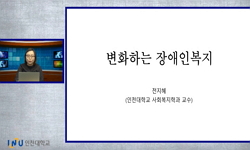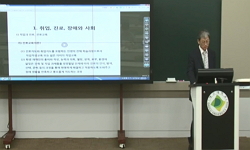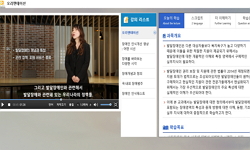The purposes of this study were to (a) examine disparity in perceived poor health status among people with and without disability, (b) compare the impact of factors, especially income level, on the perceived health status, and (c) determine the impact...
http://chineseinput.net/에서 pinyin(병음)방식으로 중국어를 변환할 수 있습니다.
변환된 중국어를 복사하여 사용하시면 됩니다.
- 中文 을 입력하시려면 zhongwen을 입력하시고 space를누르시면됩니다.
- 北京 을 입력하시려면 beijing을 입력하시고 space를 누르시면 됩니다.

장애인과 비장애인의 건강격차에 미치는 영향 요인 : 주관적 건강수준을 중심으로 = Factors Affecting the Health Inequality between People with and without Disability: Focusing on Subjective Health Status
한글로보기https://www.riss.kr/link?id=A105339976
- 저자
- 발행기관
- 학술지명
- 권호사항
-
발행연도
2018
-
작성언어
Korean
- 주제어
-
등재정보
KCI등재
-
자료형태
학술저널
-
수록면
1021-1035(15쪽)
-
KCI 피인용횟수
7
- DOI식별코드
- 제공처
-
0
상세조회 -
0
다운로드
부가정보
다국어 초록 (Multilingual Abstract)
The purposes of this study were to (a) examine disparity in perceived poor health status among people with and without disability, (b) compare the impact of factors, especially income level, on the perceived health status, and (c) determine the impact of disability status on perceived health by income level. The 2014 national survey for the people with disability and the 2013 Korea national health and nutrition examination survey were used to examine the impact of predictors on perceived poor health. logistic regression models were used to estimate the odds ratio of perceived poor health. Among people with disability, 53.7% reported poor self-rated health. People with disability were 3.76 times more likely to report perceived poor health status. The OR of perceived poor health among people with disability was higher in people with severe disability, including brain injury, renal failure, and physical disability. The impact of disability was greater in people with lower income levels. To improve the health status of persons with disability, policies are needed to reduce health disparities among socioeconomic levels.
국문 초록 (Abstract)
본 연구는 장애인과 비장애인간의 건강수준에 미치는 요인을 파악하고 특히 장애요인(장애 유무, 정도, 유형)이 미치는 영향과 소득수준에 따른 장애요인의 영향을 살펴보고자 수행되었다. ...
본 연구는 장애인과 비장애인간의 건강수준에 미치는 요인을 파악하고 특히 장애요인(장애 유무, 정도, 유형)이 미치는 영향과 소득수준에 따른 장애요인의 영향을 살펴보고자 수행되었다. 이를 위해 2014년 장애인실태조사와 2013년 국민건강영양조사 원자료 11,566건을 활용하여 장애인과 비장애인의 주관적 불건강 수준을 산출하였으며, 가중치를 적용한 복합 자료를 위한 로지스틱 회귀분석을 활용하여 장애요인이 주관적 불건강에 미치는 영향을 살펴보았다. 더불어 소득수준에 따라 장애요인이 미치는 영향을 확인하였다. 장애인의 주관적 불건강 수준은 53.7%(95% CI 52.2-55.2%)로 비장애인 14.0%(95% CI 13.0-15.0%)보다 3.8배 높았다. 일반적 요인을 보정한 후 장애인이 비장애인에 비해 주관적으로 불건강할 가능성은 3.76배(OR=3.76) 높았으며, 특히 중증장애를 가진 경우 5.58배 높았다. 장애유형별 영향은 뇌병변장애를 가지고 있는 경우 가장 컸으며(OR=11.17), 다음으로 신장 장애(OR=6.27), 지체 장애(OR=3.63) 및 정신 장애(OR=3.60) 등의 순이었다. 소득수준별로 장애유무의 영향을 살펴보았을 때, 소득수준이 높은 집단에 속한 경우 보다 소득수준이 낮은 집단에 속한 경우에 영향이 더 컸다. 연구결과를 바탕으로 볼 때, 장애인의 사회경제적 수준을 높이는 정책이 필요하다.
참고문헌 (Reference)
1 유창민, "한국복지패널로 본 한국 성인의 건강궤적과 예측요인: 장애인과 비장애인의 집단 내, 집단 간 불평등 정도를 중심으로" 한국보건사회연구원 36 (36): 440-472, 2016
2 김윤희, "지역특성이 취약집단 건강에 미치는 영향 분석" 한국인구학회 31 (31): 1-26, 2008
3 이한나, "장애인의 직업과 건강상태에 관한 연구 - WHODAS 2.0 활용-" 한국직업재활학회 24 (24): 5-28, 2014
4 최민혁, "장애인 인구집단과 일반인구집단간의 흡연율 비교: 성향점수매칭법을 활용하여" 한국보건교육건강증진학회 33 (33): 61-70, 2016
5 이소영, "장애인 건강격차의 문제와 건강지표 활용추세 - 발달장애인의 건강문제를 중심으로 -" 한국융합인문학회 1 (1): 73-106, 2013
6 김명일, "서울시 거주노인의 주관적 건강인식 연구: 다층모형 적용을 통한 개인의 노후준비와 지역효과 검증" 한국보건사회연구원 33 (33): 327-360, 2013
7 김승현, "복합표본설계 데이터의 분석방법 비교" 한국자료분석학회 19 (19): 2469-2480, 2017
8 백선숙, "독거노인의 자살생각에 미치는 영향요인" 한국자료분석학회 18 (18): 1011-1021, 2016
9 장혜영, "독거노인의 미충족 의료경험 관련 요인" 한국자료분석학회 19 (19): 3317-3329, 2017
10 강현욱, "독거노인과 비독거노인의 인지기능 저하에 미치는 영향요인: 2012년 고령화연구패널조사(KLoSA)" 한국자료분석학회 18 (18): 995-1009, 2016
1 유창민, "한국복지패널로 본 한국 성인의 건강궤적과 예측요인: 장애인과 비장애인의 집단 내, 집단 간 불평등 정도를 중심으로" 한국보건사회연구원 36 (36): 440-472, 2016
2 김윤희, "지역특성이 취약집단 건강에 미치는 영향 분석" 한국인구학회 31 (31): 1-26, 2008
3 이한나, "장애인의 직업과 건강상태에 관한 연구 - WHODAS 2.0 활용-" 한국직업재활학회 24 (24): 5-28, 2014
4 최민혁, "장애인 인구집단과 일반인구집단간의 흡연율 비교: 성향점수매칭법을 활용하여" 한국보건교육건강증진학회 33 (33): 61-70, 2016
5 이소영, "장애인 건강격차의 문제와 건강지표 활용추세 - 발달장애인의 건강문제를 중심으로 -" 한국융합인문학회 1 (1): 73-106, 2013
6 김명일, "서울시 거주노인의 주관적 건강인식 연구: 다층모형 적용을 통한 개인의 노후준비와 지역효과 검증" 한국보건사회연구원 33 (33): 327-360, 2013
7 김승현, "복합표본설계 데이터의 분석방법 비교" 한국자료분석학회 19 (19): 2469-2480, 2017
8 백선숙, "독거노인의 자살생각에 미치는 영향요인" 한국자료분석학회 18 (18): 1011-1021, 2016
9 장혜영, "독거노인의 미충족 의료경험 관련 요인" 한국자료분석학회 19 (19): 3317-3329, 2017
10 강현욱, "독거노인과 비독거노인의 인지기능 저하에 미치는 영향요인: 2012년 고령화연구패널조사(KLoSA)" 한국자료분석학회 18 (18): 995-1009, 2016
11 김은경, "노인의 연령계층별 건강관련 삶의 질 관련요인" 한국자료분석학회 19 (19): 2807-2823, 2017
12 김진영, "고용형태와 성별에 따른 주관적 건강에서의 격차: 건강자원과의 상호작용 효과를 중심으로" 한국인구학회 35 (35): 181-209, 2012
13 Bailis, D. S., "Two views of self-rated general health status" 56 (56): 203-217, 2003
14 Park, K. S., "Structural relationships among health concern, health practice and health status of the disabled" 32 (32): 276-288, 1999
15 Kenkel, D. S., "Should you eat breakfast? Estimates from health production functions" 4 (4): 15-29, 1995
16 Ross, C. E., "Sex stratification and health lifestyle: consequences for men's and women's perceived health" 35 (35): 161-178, 1994
17 Molarius, A., "Self-rated health, chronic diseases, and symptoms among middle-aged and elderly men and women" 55 (55): 364-370, 2002
18 Idler, E. L., "Self-rated health and mortality in the NHANES-I epidemiologic follow-up study" 80 (80): 446-452, 1990
19 Centers for Disease Control and Prevention, "Racial/ethnic disparities in self-rated health status among adults with and without disabilities-United States, 2004-2006" 57 (57): 1069-, 2008
20 Reichard, A., "Prevalence and reasons for delaying and foregoing necessary care by the presence and type of disability among working-age adults" 10 (10): 39-47, 2016
21 Smith, P. C., "Performance measurement for health system improvement: experiences, challenges and prospects" Cambridge University Press 2008
22 Ji, S. H., "Kangwha cohort, 8-year follow up-self rated health and mortality in elderly" 16 (16): 172-180, 1994
23 Froehlich-Grobe, K., "Impact of disability and chronic conditions on health" 9 (9): 600-608, 2016
24 Adams, P., "Healthy, wealthy, and wise? Tests for direct causal paths between health and socioeconomic status" 112 (112): 3-56, 2003
25 National Rehabilitation Center Research Institute, "Evidence-based indicator production plan for improving health of the disabled" 2010
26 Doorslaer, E. V., "Equity in the finance and delivery of health care: an international perspective" Oxford University Press 1992
27 Horner-Johnson, W., "Disparities in chronic conditions and health status by type of disability" 6 (6): 280-286, 2013
28 World Health Organization, "Closing the gap in a generation" 2008
29 Power, C., "Childhood and adulthood risk factors for socio-economic differentials in psychological distress: evidence from the 1958 British birth cohort" 55 (55): 1989-2004, 2002
30 Veronese, N., "Association of osteoarthritis with increased risk of cardiovascular diseases in the elderly: findings from the Progetto Veneto Anziano study cohort" 68 (68): 1136-1144, 2016
31 Garshick, E., "A prospective assessment of mortality in chronic spinal cord injury" 43 (43): 408-416, 2005
32 Solar O, Irwin A., "A conceptual framework for action on the social determinants of health: social determinants of health discussion paper 2" 2010
33 National Rehabilitation Center Research Institute, "2015 Disabled health care program" 2015
34 Korea Ministry of Health and Welfare, "2014 National survey for the people with disability" 2014
35 Korea Employment Agency for the Disabled, "2013 Survey on economic activities of the disabled" 2013
동일학술지(권/호) 다른 논문
-
사회경제적 특성이 체질량지수에 미치는 영향 : 우울, 식습관, 신체능력에 따른 매개효과
- 한국자료분석학회
- 안지선
- 2018
- KCI등재
-
Economic Benefit of Corporate Social Responsibility : The Case of Korean Corporations
- 한국자료분석학회
- 이유리
- 2018
- KCI등재
-
- 한국자료분석학회
- 조석희
- 2018
- KCI등재
-
전통시장의 관광 매력성이 방문객 만족과 전통시장 이미지에 미치는 영향
- 한국자료분석학회
- 김영표
- 2018
- KCI등재
분석정보
인용정보 인용지수 설명보기
학술지 이력
| 연월일 | 이력구분 | 이력상세 | 등재구분 |
|---|---|---|---|
| 2026 | 평가예정 | 재인증평가 신청대상 (재인증) | |
| 2020-01-01 | 평가 | 등재학술지 유지 (재인증) |  |
| 2017-01-01 | 평가 | 등재학술지 유지 (계속평가) |  |
| 2013-01-01 | 평가 | 등재학술지 유지 (등재유지) |  |
| 2010-01-01 | 평가 | 등재학술지 유지 (등재유지) |  |
| 2008-01-01 | 평가 | 등재학술지 유지 (등재유지) |  |
| 2005-01-01 | 평가 | 등재학술지 선정 (등재후보2차) |  |
| 2004-01-01 | 평가 | 등재후보 1차 PASS (등재후보1차) |  |
| 2002-07-01 | 평가 | 등재후보학술지 선정 (신규평가) |  |
학술지 인용정보
| 기준연도 | WOS-KCI 통합IF(2년) | KCIF(2년) | KCIF(3년) |
|---|---|---|---|
| 2016 | 1.26 | 1.26 | 1.15 |
| KCIF(4년) | KCIF(5년) | 중심성지수(3년) | 즉시성지수 |
| 1.05 | 0.98 | 0.956 | 0.4 |





 KCI
KCI 스콜라
스콜라






